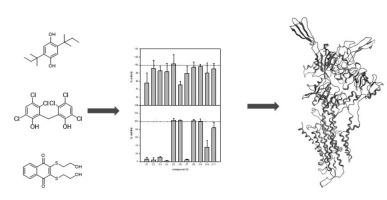Small phenolic inhibitors of PfATP6, a Plasmodium falciparum calcium ATPase, as prototype antimalarials
IF 3
3区 医学
Q2 BIOCHEMISTRY & MOLECULAR BIOLOGY
引用次数: 0
Abstract
Malaria, an infectious disease caused by Plasmodium parasites, continues to pose a serious global health problem. PfATP6, a calcium-transporting transmembrane protein present in Plasmodium falciparum, has been identified as a promising target for new antimalarial drugs, prompting searches for specific and potent inhibitors of this enzyme. Such compounds also have the potential of becoming novel research tools for the elucidation of the enzyme's physiological functions. However, only a few PfATP6 inhibitors are known to date and most of them suffer from limitations due to their high structural complexity, with high costs that restrict their availability. A notable exception is a group of structurally simple phenolic compounds that feature hydroquinone and naphthoquinone scaffolds. In order to assess the potential of this compound class as future antimalarials, we characterized a small library of these molecules in P. falciparum blood stage viability and PfATP6 activity inhibition assays. Several compounds were able to inhibit parasite growth, amongst them di-alkylated hydroquinones, a naphthoquinone disulfide, and hexachlorophene, a disinfectant. Some of the antiplasmodial compounds were also able to inhibit the activity of the purified enzyme, even though the correlation between these two properties was not absolute. The molecular interactions of active compounds with PfATP6 were analyzed by homology modeling, ligand docking, and molecular dynamics simulations, revealing a combination of hydrogen bonding and hydrophobic interactions as the main contributors to binding. The gained information constitutes a first step toward the future design of small-molecule PfATP6 inhibitors with improved properties.

小酚类抑制剂PfATP6,恶性疟原虫钙atp酶,作为原型抗疟药
疟疾是一种由疟原虫引起的传染病,继续构成严重的全球健康问题。PfATP6是一种存在于恶性疟原虫中的钙转运跨膜蛋白,已被确定为新的抗疟疾药物的有希望的靶标,促使人们寻找特异性和有效的该酶抑制剂。这些化合物也有可能成为阐明酶的生理功能的新研究工具。然而,迄今为止,已知的PfATP6抑制剂很少,而且大多数抑制剂由于结构复杂性高,成本高,限制了它们的可用性。一个明显的例外是一组结构简单的酚类化合物,其特征是对苯二酚和萘醌支架。为了评估这类化合物作为未来抗疟药物的潜力,我们在恶性疟原虫血期活力和PfATP6活性抑制试验中对这些分子的小文库进行了表征。几种化合物能够抑制寄生虫的生长,其中包括二烷基对苯二酚,一种萘醌二硫化,和六氯苯,一种消毒剂。一些抗疟原虫化合物也能够抑制纯化酶的活性,尽管这两种性质之间的相关性不是绝对的。通过同源性建模、配体对接和分子动力学模拟分析了活性化合物与PfATP6的分子相互作用,揭示了氢键和疏水相互作用的组合是结合的主要因素。获得的信息构成了未来设计具有改进性能的小分子PfATP6抑制剂的第一步。
本文章由计算机程序翻译,如有差异,请以英文原文为准。
求助全文
约1分钟内获得全文
求助全文
来源期刊

Bioorganic & Medicinal Chemistry
医学-生化与分子生物学
CiteScore
6.80
自引率
2.90%
发文量
413
审稿时长
17 days
期刊介绍:
Bioorganic & Medicinal Chemistry provides an international forum for the publication of full original research papers and critical reviews on molecular interactions in key biological targets such as receptors, channels, enzymes, nucleotides, lipids and saccharides.
The aim of the journal is to promote a better understanding at the molecular level of life processes, and living organisms, as well as the interaction of these with chemical agents. A special feature will be that colour illustrations will be reproduced at no charge to the author, provided that the Editor agrees that colour is essential to the information content of the illustration in question.
 求助内容:
求助内容: 应助结果提醒方式:
应助结果提醒方式:


